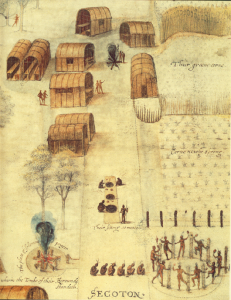
White, John. Village of the Secotan Indians in North Carolina. 1585. British Museum, London.
Within his watercolor painting, John White, an artist and mapmaker, illustrates his first-hand encounter with a coastal North Carolina village.[1] The figures seen within the artwork are the members of a Secotan Indian tribe.[2] Their way of life is detailed and depicted within the colonial time 1585. This piece is essential within sharing the story of the foundational era in the Chapel Hill region since the painting is not limited to one specific part of the Pamlico River. This body of water spans to the border of present-day Orange County, which indicates that the growth patterns and common characteristics of this portrayed area can be mirrored within the city of Chapel Hill.[3]
The image shows two fields of tobacco, a fresh field of corn, a ripe cornfield, and a pumpkin garden.[4] Their agriculture indicates that the food was all locally grown which is associated with many positive aspects such as a sense of togetherness, nutrient-rich food, and the supporting of a local economy. The tribe went to great extents to protect their corn from the birds as evidence of the huts with guards. This leans towards the idea that the community was organized and prosperous due to the specialized roles and positions that each individual took on. The river served as a source of meat that could be cooked on the fires. It seems as though the process of planting, picking, and preparing the food was a collective effort.
As opposed to earlier eras, the tribe is settled and not traveling, hunting, and gathering. The roles appear to be less gender specific as men and women are capable of agricultural duties. Within later eras, the food will be prepared over a more advanced source of heat, as opposed to the bonfire that is present within the painting. Also, the technology and machinery will advance to allow us to plant and harvest substantial amounts of crops. In the future, our knowledge of the overall nutrition, awareness of the weather, and soil conditions will aid in superior production. For understanding North Carolina at this moment, it is essential to look back into the past and see where it all began with the native peoples. Corn, pumpkins, and fish all still locally grown, traded, and enjoyed in recipes important to Chapel Hill. The methods of cooking differ greatly; however, at its roots, the fundamental crops are still prevalent, bountiful, and enjoyed by a tightknit community.
[1] “Painting the New World.” The Public Domain Review. Accessed October 8, 2018. https://publicdomainreview.org/2012/04/24/painting-the-new-world/.
[2] White, John. Village of the Secotan Indians in North Carolina. 1585. British Museum, London.
[3] Johnson, Andrea Karen. “Multitiered Health Assessment of Atlantic Menhaden in the Pamlico River, North Carolina.” Map. In ResearchGate.
[4]”Secotan, an Algonquian Village, Ca. 1585.” Gilderlehrman. Accessed October 8, 2018. https://www.gilderlehrman.org/content/secotan-algonquian-village-ca-1585.
-Amanda Campo